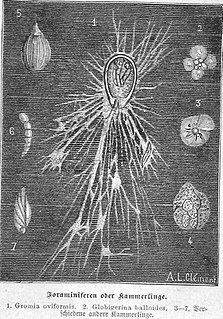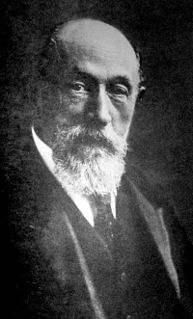
Xenophyophorea is a clade of foraminiferans. Members of this class are multinucleate unicellular organisms found on the ocean floor throughout the world's oceans, at depths of 500 to 10,600 metres. They are a kind of foraminiferan that extracts minerals from their surroundings and uses them to form an exoskeleton known as a test.

Foraminifera are single-celled organisms, members of a phylum or class of amoeboid protists characterized by streaming granular ectoplasm for catching food and other uses; and commonly an external shell of diverse forms and materials. Tests of chitin are believed to be the most primitive type. Most foraminifera are marine, the majority of which live on or within the seafloor sediment, while a smaller number float in the water column at various depths. Fewer are known from freshwater or brackish conditions, and some very few (nonaquatic) soil species have been identified through molecular analysis of small subunit ribosomal DNA.

The Antarctic realm is one of eight terrestrial biogeographic realms. The ecosystem includes Antarctica and several island groups in the southern Atlantic and Indian Oceans. The continent of Antarctica is so cold that it has supported only 2 vascular plants for millions of years, and its flora presently consists of around 250 lichens, 100 mosses, 25-30 liverworts, and around 700 terrestrial and aquatic algal species, which live on the areas of exposed rock and soil around the shore of the continent. Antarctica's two flowering plant species, the Antarctic hair grass and Antarctic pearlwort, are found on the northern and western parts of the Antarctic Peninsula. Antarctica is also home to a diversity of animal life, including penguins, seals, and whales.

The Rhizaria are a species-rich supergroup of mostly unicellular eukaryotes. Except from the Chlorarachniophyte and three species in the genus Paulinella in the phylum Cercozoa, they are all non-photosynthethic, but many foraminifera and radiolaria have a symbiotic relationship with unicellular algae. A multicellular form, Guttulinopsis vulgaris, a cellular slime mold, has also been described. This supergroup was proposed by Cavalier-Smith in 2002. Being described mainly from rDNA sequences, they vary considerably in form, having no clear morphological distinctive characters (synapomorphies), but for the most part they are amoeboids with filose, reticulose, or microtubule-supported pseudopods. Many produce shells or skeletons, which may be quite complex in structure, and these make up the vast majority of protozoan fossils. Nearly all have mitochondria with tubular cristae.

Gromia is a genus of protists, closely related to foraminifera, which inhabit marine and freshwater environments. Gromia are ameboid, producing filose pseudopodia that extend out from the cell’s proteinaceous test through a gap enclosed by the cell’s oral capsule. The test, a shell made up of protein that encloses the cytoplasm, is made up of several layers of membrane, which resemble honeycombs in shape — a defining character of this genus.

The Fusulinida is an extinct order within the Foraminifera in which the tests are composed of secreted hyaline calcite. Like all forams, they were single-celled organisms. In advanced forms the test wall was differentiated into two or more layers. Loeblich and Tappan, 1988, gives a range from the Lower Silurian to the Upper Permian, with the fusulinid foraminifera going extinct with the Permian–Triassic extinction event. While the latter is true, a more supported projected timespan is from the Mid-Carboniferous period.

The Textulariida are an order of foraminifera that produce agglutinated shells or tests. An agglutinated test is one made of foreign particles glued together with an organic or calcareous cement to form an external shell on the outside of the organism. Commonly, the order had been made up of all species of Foraminifera with these types of shells, but genetic studies indicate these organisms do not form an evolutionary group, and several superfamilies in the order have been moved to the order Allogromiida. The remaining forms are sometimes divided into three orders: the Trochamminida and Lituolida, which have organic cement, and the Textulariida sensu stricto, which use a calcareous cement. All three orders or superfamilies are known as fossils from the Cambrian onwards.

William Lucas Distant was an English entomologist.
Lukas Hottinger was a paleontologist, biologist and geologist. Hottinger collaborated with the Natural History Museum of Basel (Switzerland).

Carterinida is an order of multi-chambered foraminifera within the Globothalamea. Members of this order form hard tests out of thin calcite rods known as spicules, which are held together by a proteinaceous matrix.

Cibicides is a genus of cosmopolitan benthic foraminifera known from at least as far back as the Paleocene that extends down to the present.
Hedbergella is an extinct genus of planktonic foraminifera from the Cretaceous, described by Loeblich and Tappan, 1961, as:
Test free, trochospiral, biconvex, umbilicate, periphery rounded with no indication of keel or poreless margin; chambers globular to ovate; sutures depressed, radial, straight or curved; wall calcareous, finely perforate, radial in structure, surface smooth to hispid or rugose; aperture an interiomarginal, extraumbilical-umbilical arch commonly bordered above by a narrow lip or spatulate flap, ... Includes species otherwise similar to Praeglobotruncana but which lack a keel or poreless margin, hence is regarded as a separate genus rather than as a subgenus of Praeglobotruncana as by Banner and Blow (1959).
Globigerinoides is an extant genus of shallow-water planktonic foraminifera of family Globigerinidae. First appearing in the Oligocene these foraminifera are found in all modern oceans. Species of this genus occupy the euphotic zone, generally at depths between 10-50m, in waters which cover a range of salinities and temperatures. They are a shorter lived species, especially when compared to Globorotalia genus. As a genus Globigerinoides is widely used in various fields of research including biostratigraphy, isotope geochemistry, biogeochemistry, climatology, and oceanography.
The Peedee Formation is a geologic formation in North and South Carolina. A marine deposit, named for exposures along the Great Peedee River, it preserves belemnites and foraminifera fossils dating from the Late Cretaceous. The formation is notable for its occurrence of Belemnitella americana, known as the Pee Dee Belemnite (PDB), a long-standing standard in stable carbon isotope research.

Cyclammina is a genus of foraminifers in the family Cyclamminidae. Most species are extinct, but there are a few that are extant.

"Monothalamea" is a grouping of foraminiferans, traditionally consisting of all foraminifera with single-chambered tests. Recent work has shown that the grouping is paraphyletic, and as such does not constitute a natural group; nonetheless, the name "monothalamea" continues to be used by foraminifera workers out of convenience.
Loeblichella is a genus of foraminifera belonging to the family Globotruncanidae of the superfamily Globotruncanoidea and the suborder Globigerinina. Its type species is Loeblichella hessi. The genus was named and first described by Pessagno in 1967. Its fossil range is the Late Cretaceous Period.
Heterohelicidae is a family of foraminifera belonging to the superfamily Heterohelicoidea and the suborder Globigerinina.
Edith Kristan-Tollmann nee Edith Kristan was an Austrian geologist and paleontologist. A prolific scientist with an interest in micropalaeontology and especially the foraminifera of the Triassic and the Jurassic eras, Kristan-Tollmann published widely in her field. She is also known for originating with her husband Alexander Tollmann a thoroughly documented theory of the evolution of human legend and social structures as a result of a massive impact event which struck multiple points on earth. The latter has become known as Tollmann's hypothetical bolide.

The Saubach Formation is a geological formation in Austria and Germany, dating to about 180–174 million years ago. It was described originally as Saubachschichten in 1975, and classified as part of the Lower Jurassic Adnet Group.










